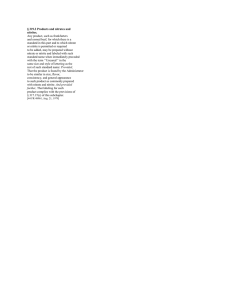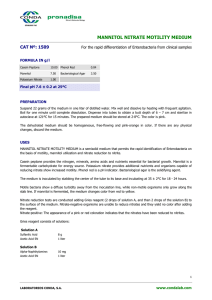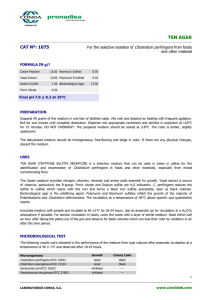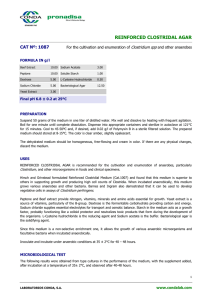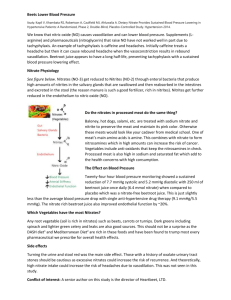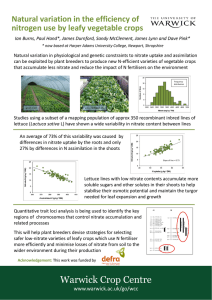NITRATE MOTILITY BASE MEDIUM CAT Nº: 1565 Clostridium perfringens
advertisement
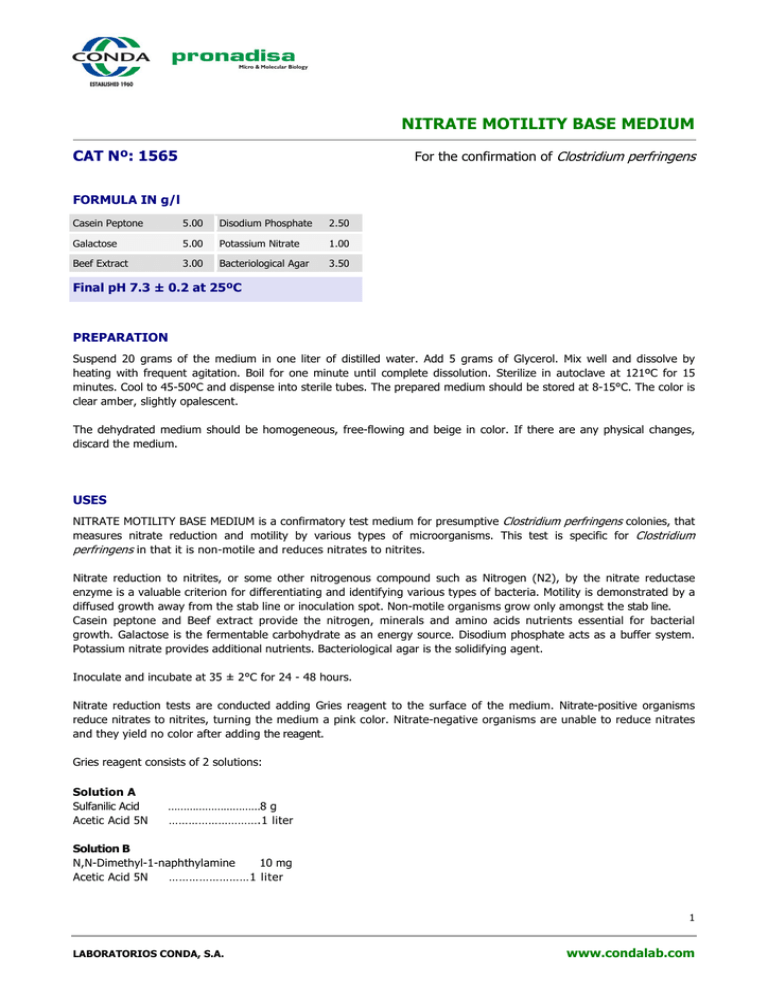
NITRATE MOTILITY BASE MEDIUM CAT Nº: 1565 For the confirmation of Clostridium perfringens FORMULA IN g/l Casein Peptone 5.00 Disodium Phosphate 2.50 Galactose 5.00 Potassium Nitrate 1.00 Beef Extract 3.00 Bacteriological Agar 3.50 Final pH 7.3 ± 0.2 at 25ºC PREPARATION Suspend 20 grams of the medium in one liter of distilled water. Add 5 grams of Glycerol. Mix well and dissolve by heating with frequent agitation. Boil for one minute until complete dissolution. Sterilize in autoclave at 121ºC for 15 minutes. Cool to 45-50ºC and dispense into sterile tubes. The prepared medium should be stored at 8-15°C. The color is clear amber, slightly opalescent. The dehydrated medium should be homogeneous, free-flowing and beige in color. If there are any physical changes, discard the medium. USES NITRATE MOTILITY BASE MEDIUM is a confirmatory test medium for presumptive Clostridium perfringens colonies, that measures nitrate reduction and motility by various types of microorganisms. This test is specific for Clostridium perfringens in that it is non-motile and reduces nitrates to nitrites. Nitrate reduction to nitrites, or some other nitrogenous compound such as Nitrogen (N2), by the nitrate reductase enzyme is a valuable criterion for differentiating and identifying various types of bacteria. Motility is demonstrated by a diffused growth away from the stab line or inoculation spot. Non-motile organisms grow only amongst the stab line. Casein peptone and Beef extract provide the nitrogen, minerals and amino acids nutrients essential for bacterial growth. Galactose is the fermentable carbohydrate as an energy source. Disodium phosphate acts as a buffer system. Potassium nitrate provides additional nutrients. Bacteriological agar is the solidifying agent. Inoculate and incubate at 35 ± 2°C for 24 - 48 hours. Nitrate reduction tests are conducted adding Gries reagent to the surface of the medium. Nitrate-positive organisms reduce nitrates to nitrites, turning the medium a pink color. Nitrate-negative organisms are unable to reduce nitrates and they yield no color after adding the reagent. Gries reagent consists of 2 solutions: Solution A Sulfanilic Acid Acetic Acid 5N …………………………8 g ……………………….1 liter Solution B N,N-Dimethyl-1-naphthylamine 10 mg Acetic Acid 5N ……………………1 liter 1 LABORATORIOS CONDA, S.A. www.condalab.com MICROBIOLOGICAL TEST The following results were obtained from type cultures in the performance of the medium after incubation at a temperature of 35± 2°C during 24-48 hours. Motility Nitrate Reduction Clostridium perfringens ATCC 13124 - + Clostridium bifermentans ATCC 638 + - Microorganisms BIBLIOGRAPHY Titters R.R. and L.A. Sancholzer 1936. The use of semi-solid agar for the detection of bacterial motility, J. Bacteriol 31: 575-580. Snell and Wright; 1941. J. Biolog. Chem. 13: 675. Compendium of methods for the microbiological examination of foods. Am. Public. Health Association. STORAGE 25ºC Once opened keep powdered medium closed to avoid hydration. 2ºC 2 LABORATORIOS CONDA, S.A. www.condalab.com
